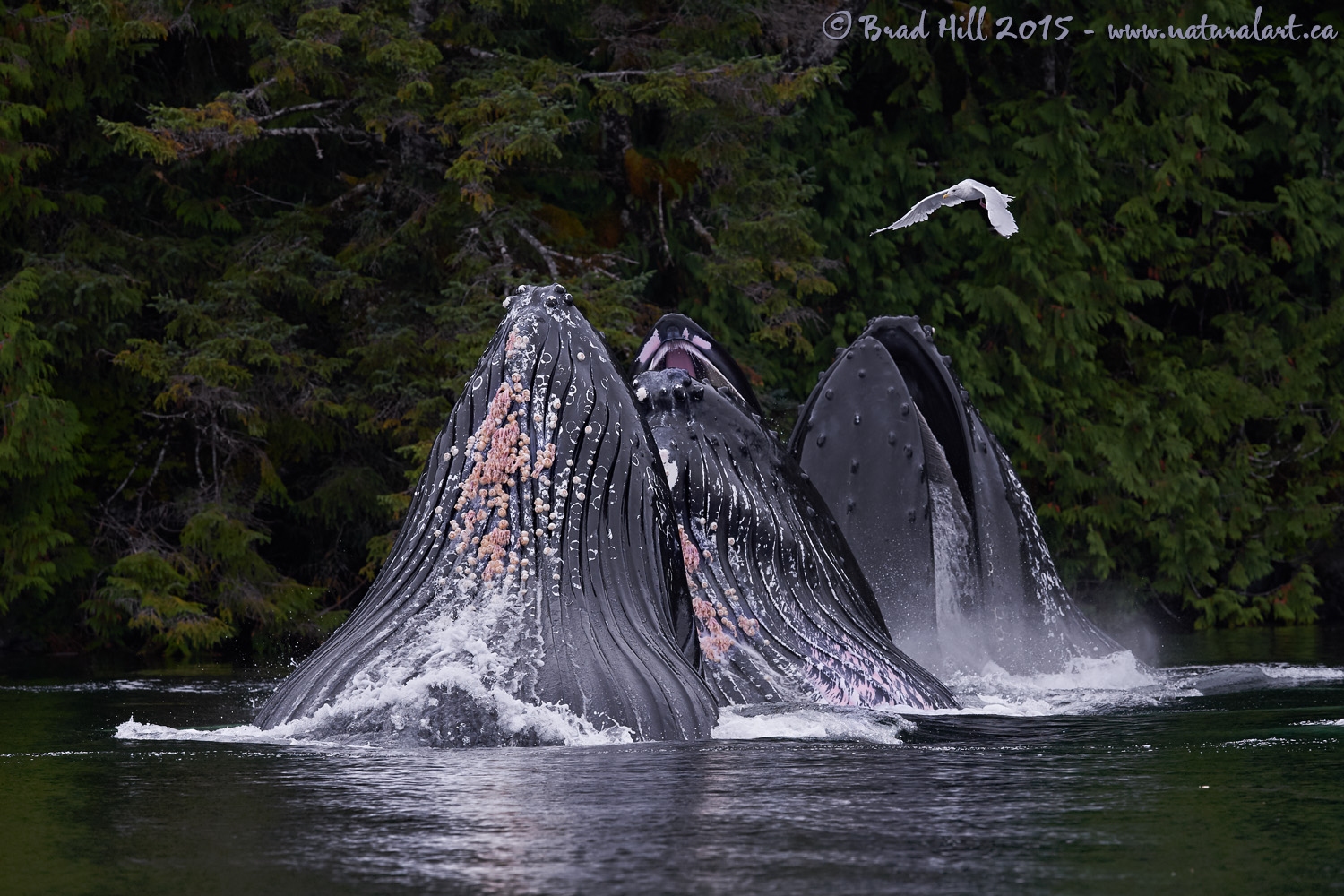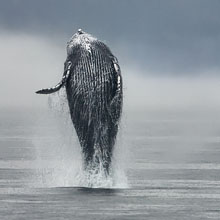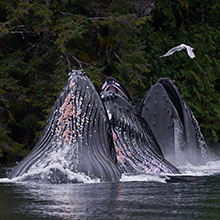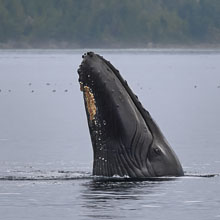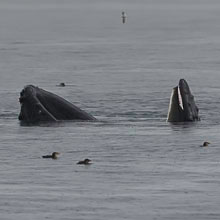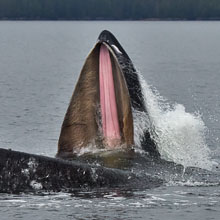Availability: Undetermined - Enquiries?
In the Field
Down the Hatch! Great Bear Rainforest (northern BC coast), BC Canada. October 7, 2014.
Watching the spectacle of bubble-netting Humpback Whales is a mind-boggling experience. This coordinated behaviour is learned and passed on from one individual - and one generation - to another through cultural transmission. You'll find this complex feeding behaviour in some specific populations of humpbacks but not in some others. Even if you're just watching them do it you become aware of their amazing intelligence. But once you find out the details of the practice, including the fact that the whales divide up the labour needed to make their bubble-nets and that each whale has a specific task to perform, their intelligence becomes even more impressive.
I captured this shot of 3 humpbacks breaking the surface during an extended bout of bubble-netting. Because there's lots of "spillage" of the small bait-fish that the whales are capturing out of the sides of their mouths, gulls are never far away. Despite how some may interpret this image, these whales aren't leaping out of the water in an effort to capture the gull! ;-)
Here you are seeing the distended lower jaws of the two closest whales and their "pleated" skin that allow the expansion of the throat that's needed to enclose tons of water (quite literally) is clearly visible. The pink circular objects all over the whale's throat are hitch-hiking barnacles that, like the gull, take advantage of the whales' sloppy eating habits for their own nourishment. The back-most whale is reversed in its orientation - you're seeing its upper jaw - and those bumps on it are called tubercules - and they're actually enlarged hair follicles. This whale has just begun expelling water through its baleen plates - straining out fish and other things (hopefully edible things!) in the process.
We've been privileged to see a long-term conservation success story with the humpbacks in the Great Bear Rainforest - sightings of them have been on the rise for years. We're now at the point where it's hard to go the Great Bear Rainforest and NOT see them. Of course, humans being what they are, there's a movement afoot to run bitumen-carrying supertankers directly through the area where this image was shot. Any spill of oil here could completely reverse the population rebound of the Humpbacks. Oh...and these waters are the same ones that took down the Queen of the North passenger and car ferry back in 2006 (and there were fatalities with that mishap). Objective scientific studies show it's not a matter of "if" there will be a serious oil spill, it's a matter of "when", with most models indicating that the probability of a major spill occurring in the next 50 years in the 80% range. It's simple lunacy to run super-tankers through the narrow channels of the Great Bear.
The detail in this image is more delectable in higher resolution form - so here's a 2400 pixel version of it for you to view:
• Down the Hatch! Download 2400 pixel image (JPEG: 1.7 MB)
ADDITIONAL NOTES:
1: This image - in all resolutions - is protected by copyright. I'm fine with personal uses of it (including use as desktop backgrounds or screensavers on your own computer), but unauthorized commercial use of the image is prohibited by law. Thanks in advance for respecting my copyright!
2: Like all wildlife photographs on this website, this image was captured following the strict ethical guidelines described in The Wildlife FIRST! Principles of Photographer Conduct. I encourage all wildlife photographers to always put the welfare of their subjects above the value of their photographs.
3: This image was captured during one of my "Into the Great Bear Rainforest" photo tours in the autumn of 2014. Each year I offer trips into two different parts of the Great Bear Rainforest as well as one to photograph aquatic mammals and oceanscapes near the northern tip of Vancouver Island. And, in selected years, I also offer photo tours to locations to capture other highly sought-after subjects, such as various owl species of the boreal forest and wildlife of Canada's Arctic. Details about these trips can be found on the Photo Tours page of this website.
Behind the Camera
Down the Hatch! Great Bear Rainforest (northern BC coast), BC Canada. October 7, 2014.
Digital Capture; Compressed RAW (NEF) 14-bit format; ISO 450.
Nikon D4s paired with Nikkor AF-S 400mm f2.8E VR - hand-held from sailboat. VR on in Sport mode.
1/1250s @ f5.6; -1.0 stop compensation from "recommended" matrix-metered exposure setting
At the Computer
Down the Hatch! Great Bear Rainforest (northern BC coast), BC Canada. October 7, 2014.
RAW Conversion to 16-bit TIFF, including first-pass/capture sharpening and slight colour tweaking using Phase One's Capture One Pro 7. Three raw variants (different versions of a single raw capture) processed, differing by a total of 0.8 stops in exposure.
Further digital corrections on resulting 16-bit TIFF files using Adobe's Photoshop CC. Photoshop adjustments included compositing (blending) of the three output files from the raw converter, selective colour desaturation, very slight exposure tweaking, and selective sharpening for web output.
Conservation
Down the Hatch! Great Bear Rainforest (northern BC coast), BC Canada. October 7, 2014.
Ten percent of the revenue generated by this image will be donated to Raincoast*.
Species Status in Canada**: Threatened - North Pacific population (May 2003).
Humpback Whales (Megaptera novaeagnliae) are active, acrobatic whales that can throw themselves completely clear of the water (a behaviour known as breaching) and will swim on their backs with both flippers in the air. Humpbacks are large (up to 14m - or 46 feet - in length and 40 tonnes in weight) and with huge flippers.
Humpbacks are found in tropical, temperate, and sub-polar waters around the world. They are found on both the east and west coasts of North America. The North Pacific population has been estimated at between 6,000 and 8,000 individuals, but only a few hundred of these are found in the waters off the coast of British Columbia.
While Humpbacks are recovering from the damage done to their populations by commercial fishing, the are still subject to a variety of threats from human activities, including becoming entangled in fishing nets, noise and chemical pollution and habitat destruction.
*The Raincoast Conservation Society (and Foundation) is an effective and efficient organization that has been fighting for protection of this unique habitat. If you are looking for a meaningful way to contribute to the conservation of this amazing ecosystem, Raincoast will provide maximal "bang" for your conservation dollars.
**as determined by COSEWIC: The Committee on the Status of Endangered Wildlife in Canada












